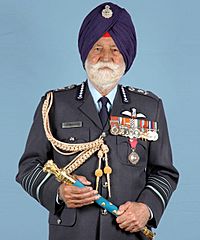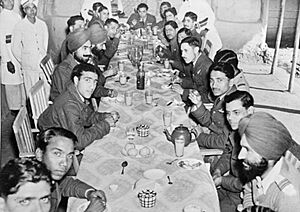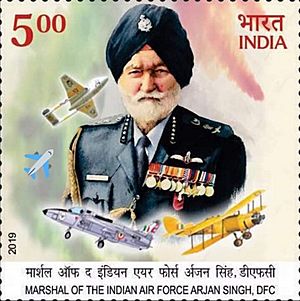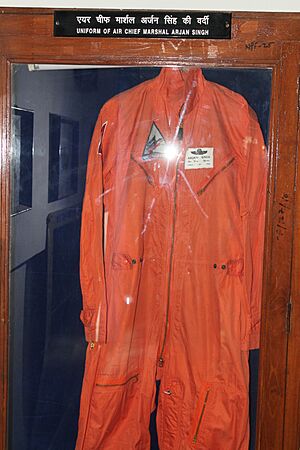Arjan Singh facts for kids
Quick facts for kids
Marshal of the Indian Air Force
Arjan Singh
|
|
|---|---|

MIAF Arjan Singh in his Marshal of the Indian Air Force uniform
|
|
| 13th Lieutenant Governor of Delhi | |
| In office Dec 1989 – Dec 1990 |
|
| Appointed by | President of India (then, R. Venkataraman) |
| Preceded by | Romesh Bhandari |
| Succeeded by | Markandey Singh |
| 11th High Commissioner of India to Kenya | |
| In office 1974–1977 |
|
| President | V. V. Giri Fakhruddin Ali Ahmed B. D. Jatti Neelam Sanjiva Reddy |
| Prime Minister | Indira Gandhi Morarji Desai |
| Preceded by | K. C. Nair |
| Succeeded by | A. N. D. Haksar |
| 9th Ambassador of India to Switzerland, the Holy See and Liechtenstein | |
| In office 27 March 1971 – 26 March 1974 |
|
| President | V. V. Giri |
| Prime Minister | Indira Gandhi |
| Preceded by | M. A. Hussain |
| Succeeded by | Avtar Singh |
| 12th Chairman of the Chiefs of Staff Committee | |
| In office 7 June 1966 – 15 July 1969 |
|
| President | Sir S. Radhakrishnan Zakir Husain V. V. Giri |
| Prime Minister | Gulzarilal Nanda (acting) Indira Gandhi |
| Preceded by | Jayanto Nath Chaudhuri |
| Succeeded by | Adhar Kumar Chatterji |
| 3rd Chief of the Air Staff (India) | |
| In office 1 August 1964 – 15 July 1969 |
|
| President | Sir S. Radhakrishnan Zakir Husain V. V. Giri |
| Prime Minister | Lal Bahadur Shastri Gulzarilal Nanda (acting) Indira Gandhi |
| Preceded by | Aspy Merwan Engineer |
| Succeeded by | Pratap Chandra Lal |
| Personal details | |
| Born | 15 April 1919 Lyallpur, Punjab, British India (now Faisalabad, Punjab, Pakistan) |
| Died | 16 September 2017 (aged 98) New Delhi, India |
| Spouses |
Teji Singh
(m. 1948; died 2011) |
| Children | 3 |
| Military service | |
| Allegiance | |
| Branch/service | |
| Years of service | 1938–1969 2002–2017 |
| Rank | Marshal of the Indian Air Force |
| Commands | Chief of the Air Staff Operational Command Ambala Air Force Station Air Force Station Kohat Air Force Station Risalpur No. 1 Squadron IAF |
| Battles/wars | World War II Indo-Pakistani War of 1947 Indo-Pakistani War of 1965 |
| Awards | |
| Later work(s) | Chairman, IIT Delhi Director, Grindlays Bank National Commission for Minorities |
Arjan Singh (15 April 1919 – 16 September 2017) was a very important officer in the Indian Air Force (IAF). He was the third Chief of the Air Staff from 1964 to 1969. He bravely led the Air Force during the Indo-Pakistani War of 1965. He was the first and only officer in the IAF to reach the highest rank of five-star as Marshal of the Indian Air Force. This rank is equal to the Field Marshal in the army.
Arjan Singh joined the Royal Air Force College Cranwell when he was 19. He became a pilot in 1939. He flew with No. 1 Squadron IAF in the North-West Frontier Province. During World War II, he commanded this squadron in the Arakan Campaign. For his bravery, he received the Distinguished Flying Cross.
After India became independent in 1947, he led the first fly-past of Indian Air Force planes over the Red Fort in Delhi. He then became the commander of Air Force Station, Ambala. Later, he became the head of the Operational Command. In 1964, he became the Chief of the Air Staff. He received the Padma Vibhushan award for his excellent leadership during the 1965 war. In 1966, he became the first IAF officer to be promoted to Air Chief Marshal.
After retiring from the IAF, Arjan Singh worked as a diplomat and advisor for the Indian Government. He was India's Ambassador to Switzerland from 1971 to 1974. He also served as the High Commissioner of India to Kenya from 1974 to 1977. From 1989 to 1990, he was the Lieutenant Governor of Delhi. In 2002, he was given the special rank of Marshal of the Indian Air Force. He was the first and only officer to receive this great honour.
Contents
Early Life and Schooling
Arjan Singh was born on 15 April 1919 in Lyallpur. This town was in British India, which is now Pakistan. His family was a Punjabi Jat Sikh family. Many men in his family had joined the armed forces before him. Arjan Singh was the fourth generation to join the British Indian armed forces.
His father was a soldier in the cavalry. His grandfather and great-grandfather also served in the army. Arjan Singh was the first in his family to become a commissioned officer. This means he became an officer, not just a regular soldier.
Arjan Singh went to school in Montgomery and then to Government College Lahore. He was a great sportsman. He was the captain of his college swimming team. He even set several swimming records in Punjab and the University. In 1938, he won the All-India One-mile swimming event. In the same year, he joined the RAF College Cranwell to become a pilot.
Military Career
World War II Service
Arjan Singh became a Pilot Officer in December 1939. He was the best Indian cadet in his pilot training course. He joined No. 1 Squadron IAF in the North-West Frontier Province. There, he flew Westland Wapiti biplanes. His squadron fought against tribal forces in the area. Once, his plane was shot down, but he was not hurt. He was flying again within two weeks.
In 1943, Arjan Singh became the acting Squadron Leader and commander of No. 1 Squadron IAF. He wanted his squadron to fight in the main war. He asked the Commander-in-Chief, Claude Auchinleck, to send them to fight the Japanese. His squadron was then sent to Imphal in early 1944.
Singh led his squadron in the Arakan Campaign in 1944. He showed great leadership and courage. For this, he was awarded the Distinguished Flying Cross (DFC) in June 1944. Lord Mountbatten presented him with the award.
After the war, in February 1945, Singh was promoted to Wing Commander. He also attended a staff course in the United Kingdom. When he returned, he commanded Air Force Station Kohat and Air Force Station Risalpur.
After India's Independence
On 15 August 1947, India became independent. Arjan Singh, now an acting Group Captain, led the first fly-past of Indian Air Force planes over the Red Fort in Delhi. He then took command of the important Air Force Station, Ambala.
In 1948, he moved to the Air Headquarters. He became the Director of Training. In 1949, he went to the Joint Service Defence College in the United Kingdom. When he came back to India in 1950, he became the acting Air Commodore. He took command of the No. 1 Operational Command.
Arjan Singh led the Operational Command twice. In 1956, he led a group of Toofani jet fighters on a friendly visit to Burma. In May 1958, he was promoted to Air Vice Marshal. He continued to lead the Operational Command. He is known for being the longest-serving head of this important command.
In 1960, Singh went to the Imperial Defence College in the United Kingdom. After that, he became the Air Officer in Charge Administration at Air Headquarters. In 1963, he became the Deputy Chief of the Air Staff. Then he became the Vice Chief of the Air Staff.
Chief of the Air Staff
In May 1964, the Indian Government chose Arjan Singh to be the Chief of the Air Staff (CAS). On 1 August 1964, he became an Air Marshal and took over as the 6th Chief of the Air Staff. He was about 45 years old at that time.
Leading in the 1965 War
In August 1965, Pakistan tried to send forces into Jammu and Kashmir. This led to a full-scale war between India and Pakistan. Pakistan launched an attack in the Akhnoor and Chhamb regions. The Indian Air Force was asked to help immediately.
Arjan Singh was called to the Defence Minister's office. He was asked for air support. He calmly replied, "in an hour." True to his word, the Pakistani attack was hit by the IAF within an hour. The IAF faced some challenges but fought back strongly.
The war ended with a ceasefire on 23 September. Arjan Singh showed amazing leadership during the war. He stayed calm and inspired everyone. For his great leadership, he received India's second-highest civilian award, the Padma Vibhushan. On 15 January 1966, the CAS post was upgraded to Air Chief Marshal. Arjan Singh became the first officer to hold this new, higher rank.
On 7 June 1966, he also became the Chairman of the Chiefs of Staff Committee. He held this position until he retired. In 1967, he was invited to his old college, the RAF College Cranwell, to review the passing out parade. This was a rare honour for a non-British officer.
Arjan Singh led the IAF for almost five years, which is one of the longest terms. He retired in July 1969, at the age of 50.
Diplomatic and Political Roles
After retiring from the IAF in 1971, Arjan Singh became India's Ambassador to Switzerland, the Holy See, and Liechtenstein. He worked there for three years.
From 1974 to 1977, he served as the High Commissioner of India to Kenya. Later, he was a member of the National Commission for Minorities from 1978 to 1981.
He also served as the Chairman of the Indian Institute of Technology Delhi from 1980 to 1983. He was a Director of the Grindlays Bank from 1981 to 1988.
On 12 December 1989, the President of India appointed Arjan Singh as the Lieutenant Governor of Delhi. He held this position for one year.

Becoming Marshal of the Indian Air Force
On 25 January 2002, the Indian Government announced a great honour for Air Chief Marshal Arjan Singh. He was given the rank of Marshal of the Indian Air Force, starting from 26 January 2002. This was to thank him for his valuable service to the Air Force and the Nation.
This rank is the highest in the Indian Air Force. It is equal to a Field Marshal in the army. Once given, this rank is held for life. The President of India, K. R. Narayanan, officially gave him the Five-star rank and the Marshal's baton in a ceremony on 23 April 2002.
Personal Life
In 1948, Arjan Singh married Teji Singh. Their marriage was arranged by their families. They were married for 63 years until Teji Singh passed away in April 2011. They had three children: a daughter named Amrita, and two sons, Arvind and Asha.
Later Years and Passing Away
In his last years, Arjan Singh's health declined. However, he remained active even at 98 years old. He continued to play golf twice a week.
On 16 September 2017, he suffered a heart attack at his home in New Delhi. He was taken to the hospital but sadly passed away that evening. Many important people, including the President and Prime Minister, paid their respects. He was given a state funeral with full military honours. The National Flag flew at half-mast in Delhi.
Legacy
Arjan Singh was the only officer to keep his flying skills until he became the Chief of Air Staff. He had flown over 60 different types of aircraft. These included old biplanes and modern jet fighters. He also flew large transport planes.
He worked for the well-being of air force veterans. He even donated a large amount of his own money to set up a trust for them. He was seen as a father figure to the Indian Air Force.
The Air Force Sports Control Board holds an annual Marshal Arjan Singh Memorial All India Hockey Tournament. In April 2019, the IAF celebrated his 100th birthday. They planned events across the country.
Air Force Station Arjan Singh
On 14 April 2016, to celebrate his 97th birthday, the Indian Air Force base at Panagarh in West Bengal was renamed. It is now called Air Force Station Arjan Singh. This was done to honour his great service. This airbase was built during World War II, where Singh also served.
Awards and Decorations
- Padma Vibhushan
- Distinguished Flying Cross
- General Service Medal 1947
- Samar Seva Star
- Raksha Medal
- Sainya Seva Medal
- Indian Independence Medal
- 1939–1945 Star
- Burma Star
- War Medal 1939–1945
- India Service Medal
Images for kids
-
U.S. President Barack Obama greets Singh during India's republic day parade, 2015.
See Also
- Field Marshal K M Cariappa
- Field Marshal Sam Manekshaw








